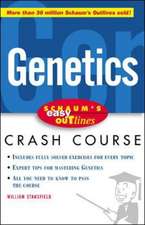Population Genetics: Developments Series
Autor J. S. Galeen Limba Engleză Paperback – 16 apr 2013
Preț: 382.36 lei
Nou
Puncte Express: 574
Preț estimativ în valută:
73.16€ • 76.39$ • 60.55£
73.16€ • 76.39$ • 60.55£
Carte tipărită la comandă
Livrare economică 04-18 aprilie
Preluare comenzi: 021 569.72.76
Specificații
ISBN-13: 9781461339267
ISBN-10: 146133926X
Pagini: 204
Ilustrații: X, 189 p.
Dimensiuni: 152 x 229 x 11 mm
Greutate: 0.28 kg
Ediția:Softcover reprint of the original 1st ed. 1980
Editura: Springer Us
Colecția Springer
Seria Developments Series
Locul publicării:New York, NY, United States
ISBN-10: 146133926X
Pagini: 204
Ilustrații: X, 189 p.
Dimensiuni: 152 x 229 x 11 mm
Greutate: 0.28 kg
Ediția:Softcover reprint of the original 1st ed. 1980
Editura: Springer Us
Colecția Springer
Seria Developments Series
Locul publicării:New York, NY, United States
Public țintă
ResearchCuprins
1. Introduction.- Natural selection.- Problems studied by population geneticists.- Approaches to our problems.- The Mendelian population.- Factors affecting the genetic composition of populations.- Summary.- 2. Selfing.- Inbreeding.- Inbreeding depression.- Difficulties in allowing for natural selection during inbreeding.- Species inbreeding to some extent in nature.- Effect of selling on genotype frequencies at a single locus.- Information needed to discuss the effect of inbreeding on the entire genotype.- The start (generation 0).- A later stage (generation n).- Proportion of lines completely homozygous at a late stage.- To determine the average number of tracts in a given generation.- To determine the average number of heterozygous ends.- To determine the average number of external junctions.- Proportion of lines homozygous at all loci.- An illustrative example.- Total length heterozygous.- Summary.- 3. Random Genetic Drift.- On the word “probability”.- Intuitive notions on the effects of drift.- Probability distribution of allele frequency.- Mean allele frequency: mean frequency of heterozygotes.- Extreme versus intermediate allele frequencies.- Circumstances under which drift may be ignored.- Long-term effects of drift.- Variable fertilities Variable population size.- Summary.- 4. Survival and Fixation of Advantageous Mutants.- Factors affecting the chance of fixation.- Genic selection. Mean and variance of the change in allele frequency.- The probability of fixation: Kimura’s formula.- Accuracy of Kimura’s formula.- The probability of fixation: some conclusions.- Initial frequency larger than 1/(2N).- Variable population size (initial frequency 1/(2N)).- Dominance in fitness.- Summary.- 5. What is the role of Drift in Evolution? I. MorphologicalCharacters.- The problem.- Harmful mutants.- Obviously adaptive characters.- “Minor” morphological variants.- Chromosomal inversions in Drosophila pseudoobscura.- Colour and banding in Cepaea nemoralis.- Sternopleural chaetae in Drosophila melanogaster.- Wing colour in Panaxia dominula.- Conclusions on morphological characters.- 6. What is the role of Drift in Evolution? II. Protein Variation.- Protein polymorphism.- Rate of nucleotide substitution: theory Rate of nucleotide substitution in practice.- A different approach Allele frequencies in geographically distant areas.- Effect of migration.- Frequency of heterozygotes.- Testing the neutral theory from frequency data: summary.- Experimental approach.- Experiments involving several loci.- Predicting selective response from biochemical studies.- Tentative conclusions.- Summary.- 7. Hitch-Hiking Effect of a Favourable Gene.- The hitch-hiking effect defined.- Effect of recombination.- The setup most favourable for hitch-hiking.- Some other situations leading to hitch-hiking.- Summary.- 8 Changes of Allele Frequency Under Natural Selection in Large Random Mating Populations.- Conditions under which the problem can be simplified.- Genic selection.- Wright’s formula.- Change in allele frequency per generation (mild selection).- Time required for a given change Allowance for drift.- Industrial melanism.- Summary.- 9. Evolution of Dominance.- Modifiers of dominance.- Disadvantageous mutants.- Advantageous mutants.- Balanced polymorphism.- Metrical characters.- Summary.- 10. Polymorphism.- Frequency of polymorphism.- Some possible explanations for polymorphism.- Heterozygous advantage: theory.- Sickle-cell anaemia.- Is heterozygous advantage common?.- Variable selective advantage: formal theory.- Measuring selectiveadvantage: formal approach.- The ecological genetic approach.- Inversions in Drosophila pseudoobscura.- Batesian mimicry in butterflies.- Final comments.- Summary.- 11. Evolution of Altruism.- Altruistic behaviour.- Kin selection.- Social insects.- Group selection.- Summary.- 12. Summary. Some Tentative Conclusions.- Appendix 1. A Misapplication of the Hardy-Weinberg Law.- If genotype frequencies do not obey the Hardy-Weinberg law what can we conclude?.- Problem.- Solution.- General comment.- Appendix 2. Some Points in Statistics.- Probability.- Mean and variance.- Probability distributions.- Binomial distribution.- Poisson distribution.- Poisson approximation to binomial distribution.- Continuous distributions.- Normal distribution.- Normal approximation to binomial distribution.- A note on chapter 3.- Some mathematical points.- Suggestions for Further Reading.

















